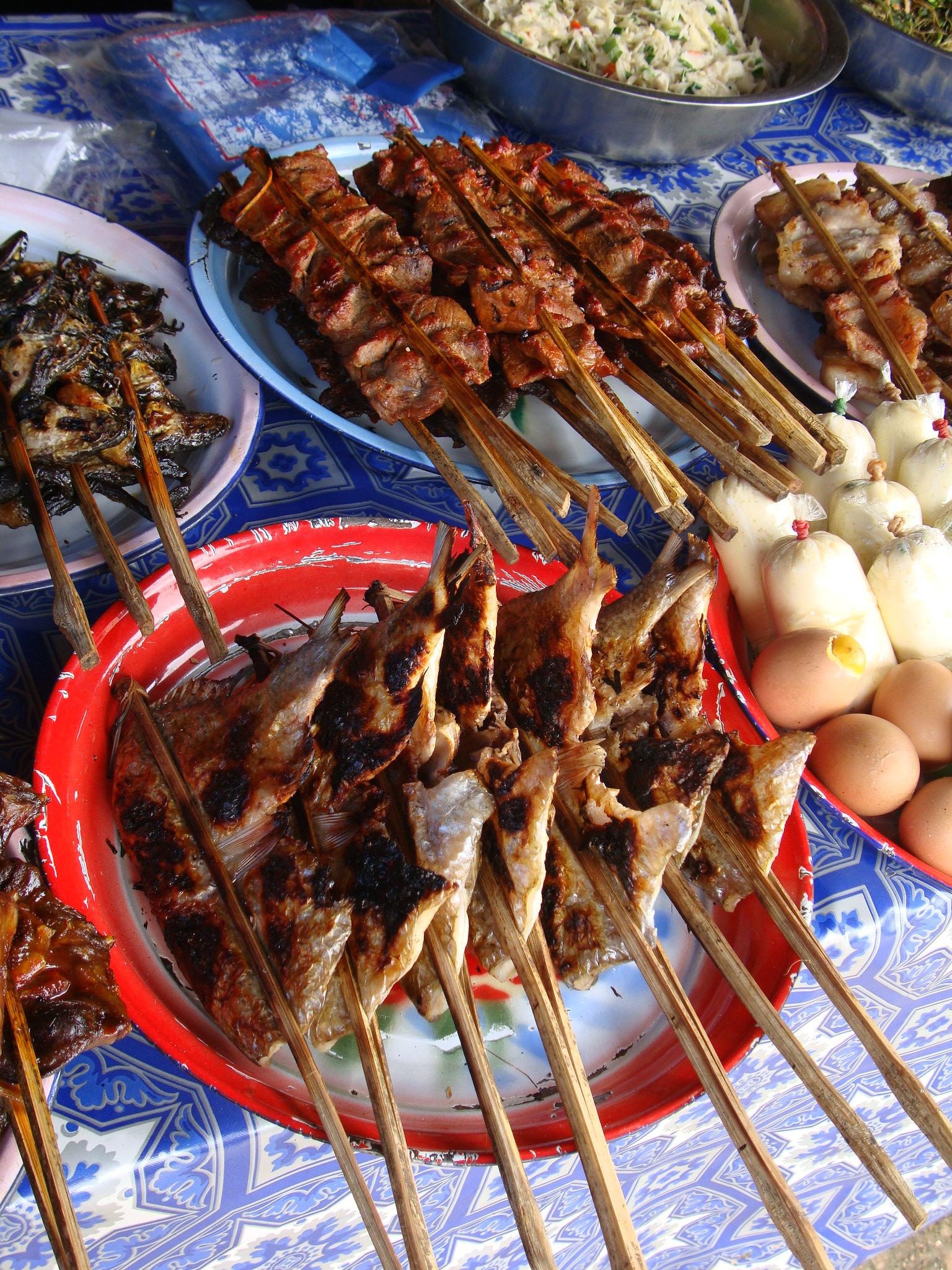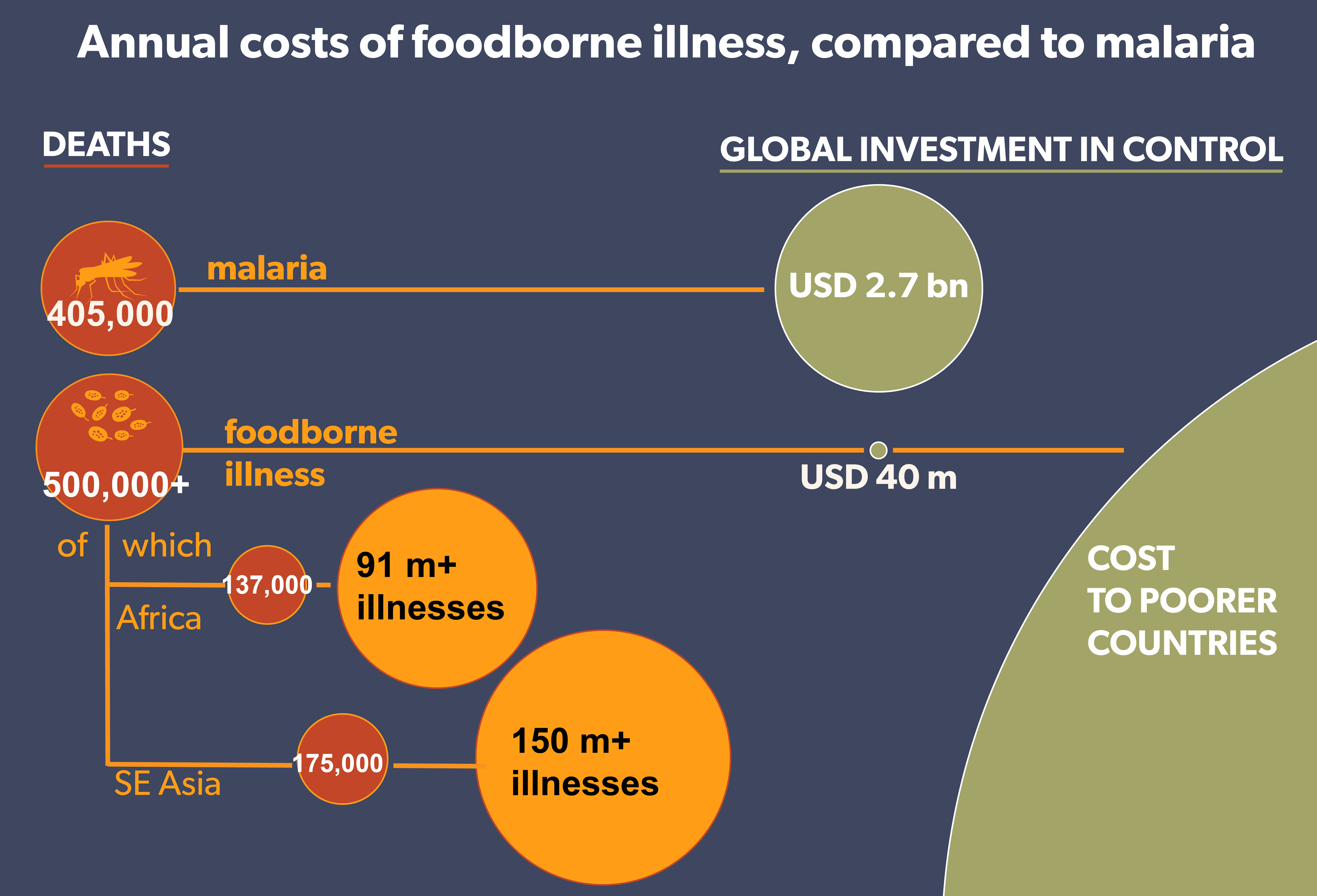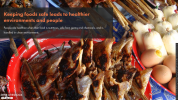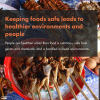
Keeping foods safe leads to healthier environments and people
People are healthier when their food is nutritious, safe from germs and chemicals, and is handled in clean environments.
Core message
Facts
- Food containing harmful bacteria, viruses, parasites or chemical substances causes more than 200 different diseases, ranging from diarrhoea to cancers.
- More than 400,000 people die and more than 600 million people fall ill every year from eating unsafe foods. The human health burden from foodborne diseases is comparable to that of malaria, HIV/AIDS or tuberculosis.
- Most foodborne diseases occur in poor countries, where they cost around USD110 billion a year in lost productivity and medical expenses.
- Children under five years of age carry 40% of the foodborne disease burden, with 125,000 deaths of under-fives every year.
- Animal-source foods contaminated with harmful bacteria and other microbes are a leading cause of foodborne diseases.
- Contamination also results in food spoilage and food waste, which increases the environmental footprint of food production.
Nutritious, safe food is paramount to people and to development. Foods from animals are critical for good nutrition in poor countries as livestock products are the most efficient way for people to acquire the proteins and vital micronutrients they need.

However, milk meat and eggs—and vegetables too—are good environments for disease-causing bacteria and other microbes (pathogens) to thrive. Some of the pathogens that contaminate vegetables can also come from animals, such as when vegetable fields are fertilized with manure from diseased animals.
Throughout Asia and Africa most livestock products and fresh produce are sold in informal markets that can be difficult to keep clean and risk free. Facilities and workplaces for livestock testing, inspection, slaughter and processing can also be risky – not just for the food but also for the people handling it and the environments receiving the waste. Frequently, food safety checks are a barrier for producers, resulting in riskier products being sold directly through unchecked channels.
The good news is that the practices that spread hazards and diseases are well known. Investments in simple solutions have been shown to be successful. This includes: promoting food safety awareness., strengthening capacities of those producing and selling foods, and investing in equipment and facility upgrades.
Investments need to be made all along food supply chains (the routes from ‘farm to fork’) to ensure inclusive and incentive-based policies, effective inspection and disposal of unsafe food and good cold chains and hygiene through from livestock production, to slaughter, processing, transport, selling and preparation.
To succeed, a joint effort is needed at different levels by veterinary, environmental and public health experts, and policy makers, food business operators and consumer groups. Coordination through a One Health approach will foster the collaboration required (see Health - Joining up multi-sectoral health investments reduces health risks and burdens to people, livestock and ecosystems).
The informal, often outdoor, food markets in most poor countries provide fresh, local, affordable and nutritious foods as well as livelihoods for billions of people. While governments work to improve food safety through better regulation, further investments are needed in community-based education, behaviour-change initiatives and appropriate, proven incentives to improve market infrastructure, processes and hygiene practices.
Food safety challenges
Consumers are at risk of illness when they eat or drink animal flesh or organs, milk or eggs infected with pathogens that can transmit from animals to people (zoonoses). These pathogens are also sometimes able to then be transmitted from person to person. Everybody who work in the food supply system, from farmers to slaughterhouse workers to food sellers and handlers, is at risk from zoonotic diseases (see Health - Keeping foods safe leads to healthier environments and people). Zoonotic foodborne illnesses include diarrhoeal disease caused by common bacteria such as Salmonella, Campylobacter and Escherichia coli.
Environmental burdens
As well as risking people’s health through consumption, producing animal-source foods can cause environmental harm and damage public health (see Health - Healthy, well cared for livestock contribute to improved animal, human and environmental health). Risks include air and water pollution, including from production and processing waste spilling into local environments. Food safety often focuses on end products and consumers, but a whole ‘farm to fork’ approach needs to look at safe outcomes for people, animals and ecosystems.
Why gender matters
Gender-based differences in activities along the supply chain are context dependent. They can also appear very slight. However, they have significant bearings on food safety. Differences in risk exposure between women and men derive primarily from gender-based differences in their work activities. There are also differences in the patterns and practices of food consumed by women and men that result in differing food safety risks (see Health - Empowering women enhances the health of people, animals and the environment).
What can be done?
Improve the safety of foods sold in traditional markets
Investments include:
- Employ locally relevant approaches and interventions to improve livestock food safety at places where food is locally sold.
- Encourage good hygiene, help build local capacity to implement improved food safety practices and introduce practical new technologies to enhance food safety in markets as well as the safety of food sellers themselves.
- Support governments to adopt risk-based approaches to food safety. This includes strengthening areas around risk assessment, risk management and risk communication
- Enhance government capacity to monitor and support food safety in markets.
- Help de-risk markets through reducing the mix of animal species and the number of live animals on market sites, increasing awareness of diseases acquired from eating wild animal products and strengthening regulation.
Improve handling and production of animals and their products
Investments should focus less on regulations and more on improved infrastructure, training and incentives to reduce the risks of animal diseases spreading and of bacterial and chemical contamination of livestock foods. Investments include:
- Improve awareness of food safety risks and safe practices among everybody involved in food production as well as among consumers.
- Improve hygiene, biosecurity and animal welfare practices in livestock farming, transportation and slaughter.
- Strengthen training and build the capacity of everybody working in food supply chains to handle food hygienically and sell safe food.
- Leverage the growing demand from consumers for safer foods to incentivize people in smallholder livestock value chains to adopt good food safety practices .
Reduce waste and environmental impacts from animal-source foods
Mountains of livestock products and other foods known to be unsafe are thrown away every year. Investments include:
- Identify and tackle hazards in livestock supply chains to reduce this waste.
- Rationalize the chemicals employed in livestock food production to enhance human and environmental health alike.
- Invest in better recycling and reuse of agriculture waste, including water.
- Provide the means and knowledge to handle livestock excreta safely.

